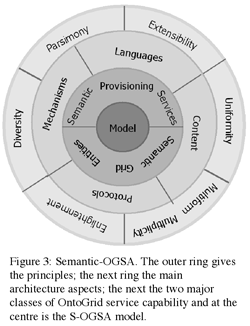 Currently the Semantic Grid lacks a Reference Architecture or any kind of systematic framework for designing Semantic Grid components or applications. OGSA aims to define a core set of capabilities and behaviours for Grid systems.14 OntoGrid extends OGSA by explicitly defining a lightweight mechanism that will allow for the explicit use of semantics and defining the associated knowledge services to support a spectrum of service capabilities. Semantic-OGSA (S-OGSA) is guided by seven design principles identified by the project (Figure 3):
Currently the Semantic Grid lacks a Reference Architecture or any kind of systematic framework for designing Semantic Grid components or applications. OGSA aims to define a core set of capabilities and behaviours for Grid systems.14 OntoGrid extends OGSA by explicitly defining a lightweight mechanism that will allow for the explicit use of semantics and defining the associated knowledge services to support a spectrum of service capabilities. Semantic-OGSA (S-OGSA) is guided by seven design principles identified by the project (Figure 3):
- 1. Parsimony: the architectural framework should be as lightweight as necessary, minimise the impact on legacy Grid infrastructure and tooling, and not dictate the definition of the contents of the descriptions – these will be application or middleware dependent.
- 2. Extensibility: rather than define a complete and generic architecture, define an extensible and customisable one. Generality is the enemy of applicability.
- 3. Uniformity: Semantic Grids are Grids, so all knowledge services are OGSA-compliant Grid services, and semantic descriptions have a lifetime and a life cycle just like other Grid entities. As metadata stores and ontology services are just special kinds of data services, we have adopted the OGSA-Data Access and Integration specification15 for their deployment and can potentially exploit other data grid capabilities.
- 4. Diversity: a dynamic ecosystem of Grid services ranging over a spectrum of semantic capabilities will coexist at any one time. Semantic capability may be possible for some Grid resources all of the time, all Grid resources some of the time, or not all resources all of the time.
- 5. Multiform + Multiplicity: the same semantic description may be captured in many representational forms (text, logic, ontology, rule) and any resource’s property may have many different descriptions.
- 6. Enlightenment: services should have a straightforward migration path that enables them to become knowledgeable and minimise the cost of doing so.
- 7. Conceptual: S-OGSA is a reference architecture. Thus it should apply equally to different Grid middleware platforms such as the Globus Toolkit,16 the EU EGEE gLite platform,17 the UK Open Middleware Infrastructure Institute Release,18 or regular Web Services.
These principles pervade OntoGrid development and our thinking.






